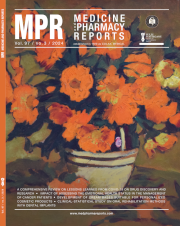Development of cream bases suitable for personalized cosmetic products
DOI:
https://doi.org/10.15386/mpr-2765Keywords:
personalized cosmetic products, antimicrobial agents, texture analysisAbstract
Background and aims. The individualization of cosmetic products or personalized dermatology preparations are in great demand at the present time.
Methods. 24 emulsifying cream bases were proposed which were prepared by the classical, automatic and semi-automatic methods, respectively, and the physical stability resulted from the three types of homogenization was taken into account. Texture parameters were also studied for the most stable cream bases in the preformulation stage and the t - statistical test was applied. In order to choose the most optimal preservative, the effectiveness of the NipaEster solution 0.1%, Cosgard and Euxyl® PE 9010 was tested on the strains of Staphylococcus aureus, Pseudomonas aeruginosa, and Candida albicans.
Results. 9 cream bases were stable through all the preparation methods used, and preservation was achieved with Euxyl® PE 9010. Following the texture parameters, significant differences were observed for the same formula in the case of choosing a different preparation method.
Conclusions. Formulas F1, with methyl glucose sesquistearate as emulsifier, F8, with cetearyl glucosite as emulsifier, and F14, with Ceteareth-20 can be used as cream bases for customized products.
Downloads
Published
How to Cite
Issue
Section
License
The authors are required to transfer the copyright of the published paper to the journal. This is done by agreeing to sign the Copyright Assignment Form. Whenever the case, authors are also required to send permissions to reproduce material (such as illustrations) from the copyright holder.

The papers published in the journal are licensed under a Creative Commons Attribution-NonCommercial-NoDerivatives 4.0 International License.

